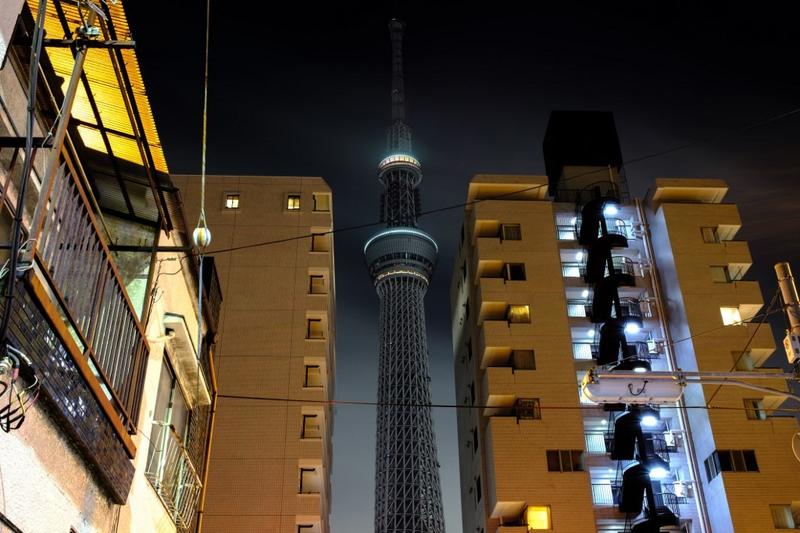 The Tokyo Skytree (center) is seen next to residential buildings, with most of its lights turned off as part of energy-saving measures following a government electricity supply warning for the capital and surrounding areas, in Tokyo on March 22, 2022. (PHILIP FONG / AFP)
The Tokyo Skytree (center) is seen next to residential buildings, with most of its lights turned off as part of energy-saving measures following a government electricity supply warning for the capital and surrounding areas, in Tokyo on March 22, 2022. (PHILIP FONG / AFP)
TOKYO – Japan scrambled on Monday to avert a looming power crunch as temperatures climbed nationwide, with authorities warning of higher than expected demand after the rainy season ended in the capital, Tokyo, at its earliest since record-keeping began.
READ MORE: Japan lifts power-supply warning for Tokyo, surrounding areas
Electricity demand has been staying above yesterday's forecast since this morning, amid unseasonably intense heat.
official of the Ministry of Economy, Trade and Industry
Less than two weeks ahead of an election for the upper house of parliament, surging electrical prices are making life tougher for Japanese customers, following higher fuel costs brought by the Russia-Ukraine conflict.
A power shortage could batter the fortunes of the ruling Liberal Democratic Party, already under fire for its handling of higher consumer prices.
"Electricity demand has been staying above yesterday's forecast since this morning, amid unseasonably intense heat," an official of the Ministry of Economy, Trade and Industry told a news conference, adding that demand had outstripped predictions.
Tuesday was expected to be the same, it added in a statement later.
At 4:00 pm, temperatures in downtown Tokyo stood at 35.1 C, while in Sano, slightly to the north, they were at 39.8 C.
Ministry officials had warned reserve generating capacity would drop as low as 3.7 percent, close to a minimum of 3 percent that ensures stable supply, from 4:30 pm to 5 pm (0730 GMT to 0800 GMT) on Monday in Tokyo and eight surrounding prefectures. Below 3% risks power shortages and blackouts.
"The supply-demand outlook, based on the latest weather forecast and other factors, is still expected to remain below the 5 percent reserve ratio during some evening hours," the official added.
ALSO READ: Japan warns of blackouts, issues dire plea to save energy
If temperatures rose further and demand increased, or power supply was suddenly disrupted, the ratio could fall below the 3 percent minimum, he said.
"We encourage people to cut back on energy use to a reasonable degree," deputy chief cabinet secretary Yoshihiko Isozaki told a news conference.
He advised turning off lights not in use, limiting use of air conditioners and guarding against the risk of heat stroke
He advised turning off lights not in use, limiting use of air conditioners and guarding against the risk of heat stroke.
Tokyo residents said they were doing their best to comply, but some queried the requests.
"It's not that I don't get what the government's saying, but they want us to save electricity and still use air conditioning - which seems contradictory," said Kenichi Nagasaka, 61.
Weather officials said the end of the annual rainy season across much of Japan, including the Tokyo metropolitan area, had come at its earliest since the data began to be kept in 1951.
Summer heat starts with the end of Japan's rainy season. In 2018, the June 29 end of the season brought an extremely hot summer with several heat waves that put thousands in hospital.
The heat is suspected to have caused two deaths at the weekend, one of a man in his 40s who collapsed outdoors, media said.
Though expected to do well in the election, Prime Minister Fumio Kishida's ruling LDP faces headwinds from rising prices, worsened by a weak yen currency.
READ MORE: Japan not considering new nuke plants despite energy security
Support for his government, while still strong, has been edging lower in opinion polls, with a majority of voters unhappy about its efforts to rein in prices.T he addition of power outages could fuel discontent.
Since spring, utilities and the government have taken steps to avert a power crunch during the peak season of summer demand.
They have asked families and businesses to conserve energy between July 1 and Sept 30, while rebooting ageing gas-fired power plants and altering maintenance plans for nuclear reactors.


